Defining terrorism isn’t easy. Kamalhasan calls Nathuram Gadse the first Hindu terrorist but Madhu Purnima Kishwar retorts by tweeting that some people ‘can’t tell the difference between a terrorist and an assassin. The latter is not a complimentary term. Kennedy’s killing was an assassination and never called a terrorist act. So also Gandhi’s murder by Godse. But Jinnah’s Direct Action Day for mass slaughter of Hindus was terrorism.’ Experts from around the world believe that the word jihad stands for terrorism and the Tamil word Theeviravaadhi describes both terrorism as well as extremism. There is then the dreaded red terrorism where Maoists are deeply entrenched with their own peculiar set of beliefs. However, the consensus on acts of violence intended to create a sense of fear come nearest to defining terrorism. It is widely agreed that illegal acts of violence done for a religious, political, or ideological goal is the broad umbrella under which the tenets of terrorism rest.
Clearing misconceptions
Terrorism, however, isn’t always about killing people. If this were the case, the causes of death in 2010 can be an eye-opener. According to an Oxfam study, as compared to 13,186 deaths dues to terrorism, there were 6,000,000 deaths because of tobacco, 3,500,000 because of under-nutrition, 2,800,00 because of obesity and so on. Malaria, diarrhea, air pollution, alcohol consumption, road traffic, and even suicide caused more deaths than terror attacks. The Urban dictionary uses the word ‘manipulation’ to individuals and groups that may be used to get a forceful agreement through fear. Now if radicalization is all about manipulation of innocent minds, so would be policies and declarations by many democratic governments, bureaucrats, corporates bosses, and even over-zealous parents. However, what must be clear is that terrorism is when manipulations lead others to resort to acts of illegal violence. Advertisements and marketing strategies, for instance, sometimes work their way through subliminal manipulation but aren’t subversive in a physical manner. A parent injecting fear of a flaccid future in a small child to make him or her spend more time attending to tasks that schools set, is definitely breaking unwritten laws of relationships but isn’t compelling them to go out and burn buses or pelt stones. Whistle-blowers, RTI activists, writers, cartoonists, and dissidents aren’t terrorists by any definition. Even those creating obstacles for them aren’t terrorists though they may appear to be unleashing a certain brand of terror that must certainly be criticized and sanitized at some point. The right form of education and legislations can easily curb these tendencies. The point that I am trying to make is that wherever there is a scope for dialogue before violence steps in, isn’t terrorism.
This story can never claim to be complete unless ‘bhagwakaran’ is included. High-decibel slogan-mongering by a certain section of ‘liberals’ insists that the term needs to be classified as Hindu terrorism but they are probably missing out on the fact that a couple beaten on valentine’s day, moral policing in parks by a Bajrang Dal or Shiv Sena, throwing slippers at airline employees, and slapping cops cannot be equated with suicide bombers killing statesmen and car bombs shattering dreams of thousands of innocents. These incidents, including the utterly deplorable violent antics by Gau-Rakshaks are NOT representative of the Hindu community that has tolerance written in bold in its chromosomal structure. These incidents also reflect a lax local government that must be nudged to wake up and act. Directives asking girls not to wear jeans or not to eat chowmein or avoid using mobile phones are, at best, the result of some idiot assuming he or she has the power to think for others and needs the right form of stringent intervention. The harebrained clout of these dolts cannot match the destructive impact of terrorists.
Putting real terror in perspective
Terrorists, I believe, disrespect and disbelieve in dialogue unless they indulge in them to buy more time. Terrorists have a monologue running through their subverted minds that isn’t open to suggestions. What we call terror could have had a start in any of the millions of reasons existing today and could be because of a skewed power ratio between the government and its challenger, a misrepresented logic in the minds of an individual or a group of individuals revolving around social, economic, and political oppression, deliberately distorted religious and political rhetoric, or sometimes a simple hunt for easy power disguised as a cause worth fighting for. The more dangerous examples tend to mirror rational behavior contorting into a disruptive pattern when time is favorable. Thus different forms of terror activities have different origins. IS and the Maoists are mainly because of ‘mutilated religious or political rhetoric’.
Whatever be the case, the one fact that is true is that terrorists aren’t just runaway lunatics rubbing law enforcement agencies the wrong way. Terrorists are people who have convinced themselves of the validity of the goal that they aim to reach and will employ any form of violence to seek the attention of the prevalent social system.
The constantly changing face of terrorism
Terrorism had humble beginnings and was simply ‘terrible’ in 1160 and slowly in around a couple of centuries it became ‘terreur’ that finally adopted its current spelling as it hopped from the middle ages to modern times. Epistemologically the term terror may not seem as intensely bullying as it really is in action, but that is simply because these six alphabets will most of the time lead to an escalation of disharmony in more than one way that compels the military to make an entry to restore peace.
These terror-soaked disturbances can be fatal for economies that have not diversified enough. They have a tendency to destabilize countries where only one form of activity exists. The Easter attack in SriLanka is an example of the real damage being directed towards tourism that obviously has long-term debilitating effects on the economy of that country.
Terrorism in 2019 includes the Maidan Shar attack where around 200 people died in Afghanistan and the perpetrator happens to be the Taliban, nearly 140 people died in the Kaduna State massacre in Nigeria and the suspects were the Adara Militis, the Dozo Dogon militia killed more than 150 people in Northern Mali, and quite recently more than 500 people died in the the Sri lankan Easter bombings where the National Thowheeth Jama’ath was seen as the main perpetrator.
An article in FP or Foreign Policy says that ‘the threat posed by Middle Eastern terrorists has been shrinking for some time’ and proclaims that Islamist terrorism is outdated in the face of the menace rising in the former Soviet states and beyond. They quote the 2017 truck strikes on pedestrians in New York and Stockholm by Uzbeks, the 2016 suicide bombing of Istanbul’s airport by a Russian national, and the 2017 attack on a nightclub in the same city, led by an Uzbek. The same article mentions that militants from Russian-speaking areas who have fought in wars in the Middle East as graduating into global terrorists. The article also claims that Rohingyas were now involved ‘in a global struggle for Islam’.
Contemporary forms of terrorism use the social media as parasites treat their preferred substrate. Terrorism knows that the internet is a powerful medium with 2.46 billion users hooked to social media platforms. Terrorists, therefore, use the virtual highway for propaganda escalation, recruitment, as well as fund-raising. The world has already seen how the ISIS effectively radicalizes susceptible minds and creates not just lone wolves but even large groups to willingly move away and into the wilderness of extremism.
However, whatever be the face of terrorism at any time, the one thing that is certain is that at the base of their contorted conviction is a mind that exists in a rather reactive mode. It is always about minds willing to accept logic that uses religion, caste, creed, community, language, and regions to raise the flag of a divisive debate invariably ending in explosions and deaths.
Terrorism for India
Major terror attacks will include the 2014 Assam violence, the Manipur ambush and the Gurdaspur attack in Dina Nagar of 2015, Pathankot, Uri, and Kokrajhar attacks in 2016, the Sukma and the Amarnath yatra attacks of 2017, and then the Pulwama attack in 2019. Even this abbreviated list is enough evidence to show the broad horizon of the nature of terrorism in the country. The belief that every terrorist attack has its origin in Pakistan can be misleading. However, Pakistan is definitely said to be a safe haven for terrorist groups like Al-Qaeda, Lashkar-e-Omar, Lashkar-e-Taiba (LeT), Jaish-e-Mohammed (JeM) and Sipah-e-Sahaba, Jaish ul-Adl, Al Badr Mujahideen, Harkat ul Mujahideen, ISIS-KP, and even Taliban besides a number of smaller groups that keep popping up and merging into whichever is bigger and smarter.
Coercive diplomacy, the application of economic sanctions, military action, withdrawal of security to separatist mindsets, working to get international support, activating support at the UN, efforts to isolate Pakistan and other countries known to lend a helping hand to terror-oriented activities, and obviously an increase in retributive cross-border strikes are just a few of the ways of dealing with rising terrorism. These are definitely not enough.
I asked a friend who has retired from the armed forces about the sort of actions that are essential to deal with terrorism and he replied, ‘Counter-terrorism measures in their predictable format normally talk about preemptive or reactive military action, fortification and other technical means, increased intelligence and surveillance activities, preemptive humanitarian activities, and more permissive interrogation and detention policies for the suspected terrorists’. This friend also informed me that besides a more comprehensive training schedule, our forces stationed on the borders now have access to better arms. For instance, considering the way the terrorists are being taught techniques in camouflage and concealment and the way they are moving in and out with military precision, it was essential to counter this menace with effective sniper action. Thus our forces now have the Beretta .338 Lapua Magnum Scorpio TGT and the Barrett .50 calibre M95 deployed at the LoC ahead of the infiltration season. These rifles come with enhanced range capabilities and are able to pierce through metal even at distances of 1800 metres and more. These sniper rifles have high-powered, long-range abilities and were used in the Afghanistan and the Iraq wars.
Aim is to turn ISIS into WASWAS
So yes, countering terrorism is certainly a global necessity today. This is because acts of terrorism invariably result in lost GDPs and low stock indices that can have devastating effects on the economy of any nation. It is also believed by some that fighting terrorism is like waging a battle against ideas and ideologies that are bent upon risking everything that has been built over thousands of years. There will always be people for and against every conceivable action that the decision-makers come up with… and the truth is that any single action will anyway be insufficient. For instance, withdrawing the MFN status for Pakistan as a stand-alone action isn’t going to deter neither the erring neighbor nor any terrorist group. It is always a bouquet of actions with a dynamic range of actionable decisions that have the ability to change form according to the need of the time that may have the desired output.
Another alternative to a viable combination of stringent military, political, and socio-economic actions is what people like Aberjhani believe promote by suggesting that ‘we are living in an era in which billions of people are grappling to promote communication, tolerance, and understanding over the more destructive forces of war, terrorism, and political chaos that have characterized the beginning of the 21st Century.’ In simple terms this means quite literally attempting to use the soul of non-violent engagements to convert the isis chant of our times into a waswas reality for tomorrow… though I’m not sure if solutions can ever be that simple.
.
.
.
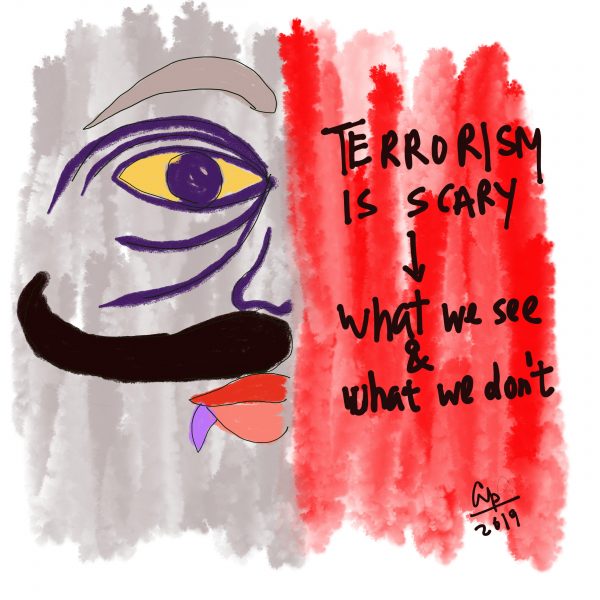
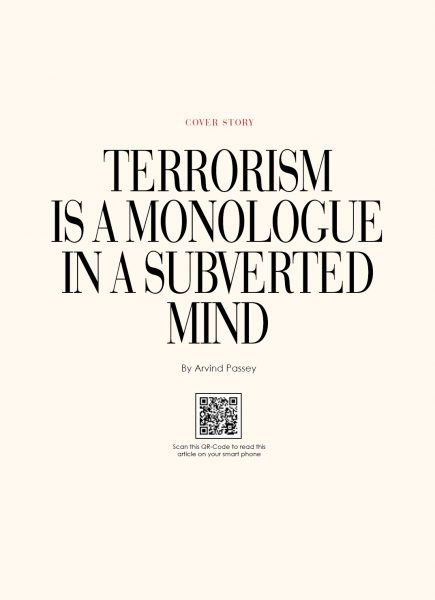
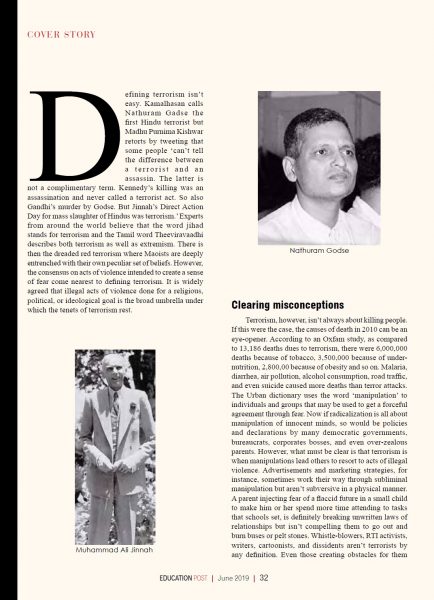
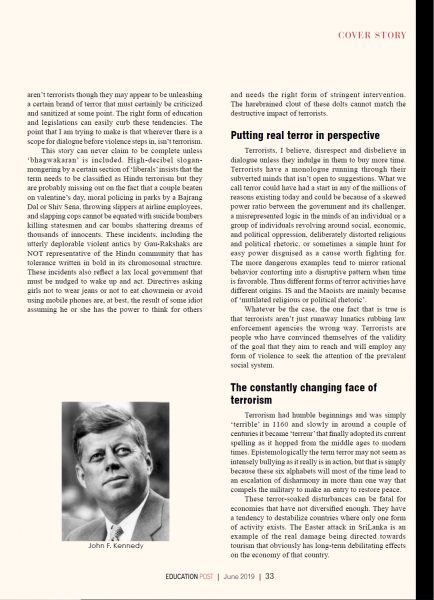
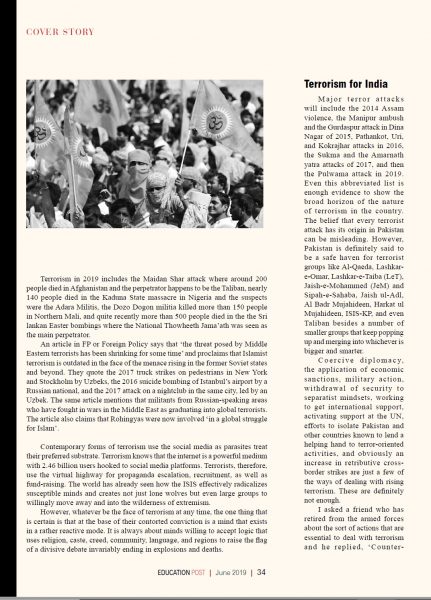
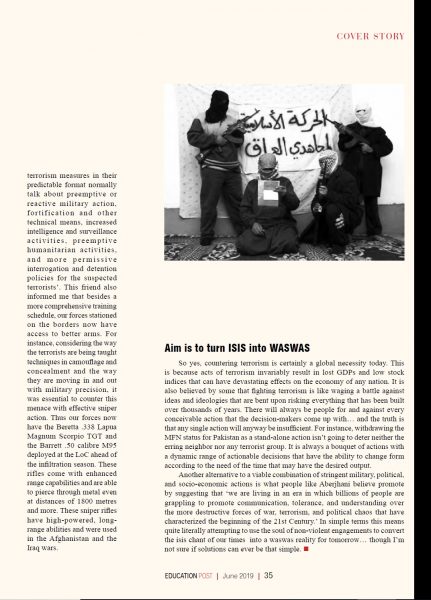
Note: This post was first published in The Education Post, June 2019
.
.
Arvind Passey
31 May 2019









2 comments
satishb says:
Jul 2, 2019
Islamic terrorism has to be seen as a unique form of terrorism that it is. There may not be an overarching definition of terrorismm but Islamic terrorism cannot be countered by economic or political solutions. It requires psychocultural solution. We need to understand the flaws of Islam and acknowledge them and counsel muslims on eradication of these flaws. For that we will have to give our fake concepts of freedom of speech and human rights with respect to Islam. Those parts of Islam that are not compatible with humanity will have to be excised and disposed of.
Arvind Passey says:
Jul 2, 2019
Thanks for sharing your opinion, Satish… looking forward to your reading more posts here.
Yes, a psycho-cultural realignment may sound innovative but to go beyond just another gust of wild and whirling words, the concept needs to starting showing the ‘how’ of every step. Telling leads to re-telling and then it goes on until the concepts itself undergoes a hideous mutation.